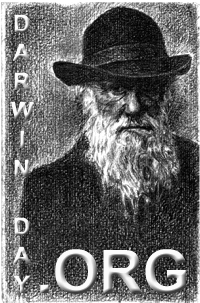|
- Human Evolution You Figure it Out! Sites with simple clear logic so that even creationists can understand. |

Join the
celebration
February
12th

Check
the AiS collection of books on evolution
&
related science.

PBS Evolution
Video explores the scientific meaning of the word "theory"
|
Evolution
of Life
Since the beginning of the fossil record, many new life forms have appeared, and most old forms have disappeared. The many traceable sequences of changing anatomical forms, inferred from ages of rock layers, convince scientists that the accumulation of differences from one generation to the next has led eventually to species as different from one another as bacteria are from elephants. The molecular evidence substantiates the anatomical evidence from fossils and provides additional detail about the sequence in which various lines of descent branched off from one another. Although details of the history of life on earth are still being pieced together from the combined geological, anatomical, and molecular evidence, the main features of that history are generally agreed upon. At the very beginning, simple molecules under chemically directed processes formed more complex molecules that eventually under selective pressures resulted in simple cell-like entities capable of self-replication. Life on earth has existed for three billion years. Prior to that, simple molecules may have formed complex organic molecules that eventually formed into cells capable of self-replication. During the first two billion years of life, only microorganisms existed—some of them apparently quite similar to bacteria and algae that exist today. With the development of cells with nuclei about a billion years ago, there was a great increase in the rate of evolution of increasingly complex, multicelled organisms. The rate of evolution of new species has been uneven since then, perhaps reflecting the varying rates of change in the physical environment. Natural selection is accelerated when environmental conditions become significantly different and harsh. If the conditions become harsh enough, only a few (or no) organisms survive. A central concept of evolution is natural selection, which arises from three well-established observations: (1) There is some variation in heritable characteristics within every species of organism, (2) some of these characteristics will give individuals an advantage over others in surviving to maturity and reproducing, and (3) those individuals will be likely to have more offspring, which will themselves be more likely than others to survive and reproduce. The likely result is that over successive generations, the proportion of individuals that have inherited advantage-giving characteristics will tend to increase. Selectable characteristics can include details of biochemistry, such as the molecular structure of hormones or digestive enzymes, and anatomical features that are ultimately produced in the development of the organism, such as bone size or fur length. They can also include more subtle features determined by anatomy, such as acuity of vision or pumping efficiency of the heart. By biochemical or anatomical means, selectable characteristics may also influence behavior, such as weaving a certain shape of web, preferring certain characteristics in a mate, or being disposed to care for offspring. New heritable characteristics can result from new combinations of parents' genes or from mutations of them. Except for mutation of the DNA in an organism's sex cells, the characteristics that result from occurrences during the organism's lifetime cannot be biologically passed on to the next generation. Thus, for example, changes in an individual caused by use or disuse of a structure or function, or by changes in its environment, cannot be promulgated by natural selection. By its very nature, natural selection is likely to lead to organisms with characteristics that are well adapted to survival in particular environments. Yet chance alone, especially in small populations, can result in the spread of inherited characteristics that have no inherent survival or reproductive advantage or disadvantage. Moreover, when an environment changes (in this sense, other organisms are also part of the environment), the advantage or disadvantage of characteristics can change. So natural selection does not necessarily result in long-term progress in a set direction. Evolution builds on what already exists, so the more variety that already exists, the more there can be. The continuing operation of natural selection on new characteristics and in changing environments, over and over again for millions of years, has produced a succession of diverse new species. Evolution is not a ladder in which the lower forms are all replaced by superior forms, with humans finally emerging at the top as the most advanced species. Rather, it is like a bush: Many branches emerged long ago; some of those branches have died out; some have survived with apparently little or no change over time; and some have repeatedly branched, sometimes giving rise to more complex organisms. The
modern concept of evolution provides a unifying principle for
understanding the history of life on earth, relationships among
all living things, and the dependence of life on the physical
environment. While it is still far from clear how evolution works
in every little detail, it is so clearly evident well established that it provides
a framework for organizing most of biological knowledge into a
coherent picture. For another more detailed description of what evolution is see: http://www.talkorigins.org/faqs/faq-intro-to-biology.html OR EVEN BETTER GET A GOOD BOOK
|
